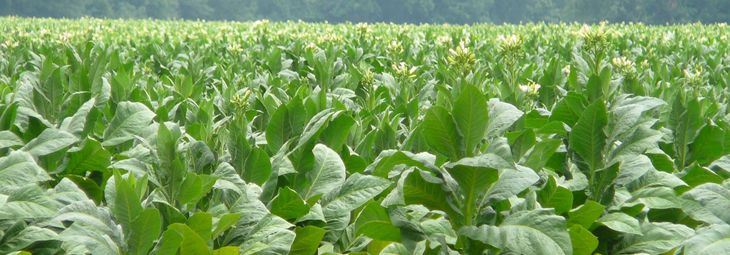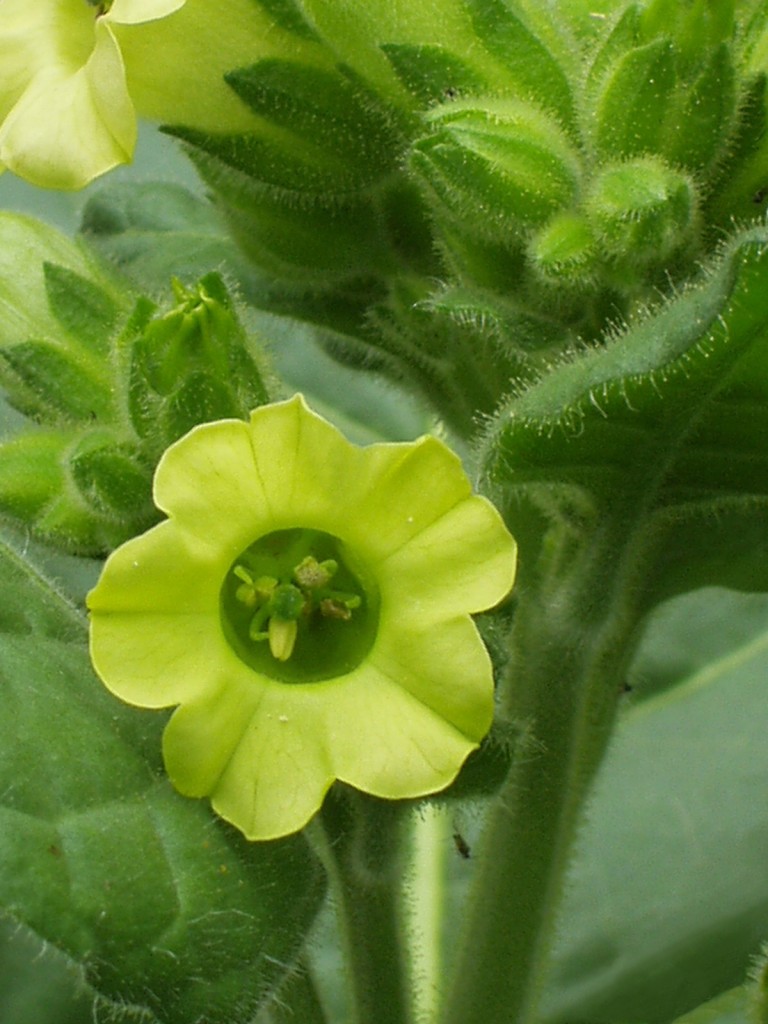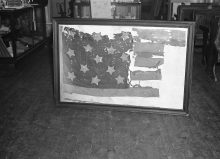Tobacco farming was hard work
by
Sam Perkins
My father grew burley tobacco in Middle Tennessee for forty continuous years. I was a participant in that endeavor for twenty of those years. Dad often said that a tobacco crop was a thirteen month job; meaning you started the next crop before the last was completed.
Tobacco plants were grown in what we called a plant bed, technically a cold frame. Before the advent of chemical weed killers, the plant bed was “burned”. This was a day long operation in which logs, scrap wood, and brush was burned on a strip of soil about eight feet wide and as long as you felt was needed. The burning killed the weed seeds. The strip of soil was outlined with timbers and the soil worked up.
Plants were pulled individually
Tobacco seeds are very small, no larger than the end of a sharp lead pencil. The seeds were broadcast on the plant bed, and walked on so there were no spots not covered by a footprint. Dad always planted tomato, lettuce and radish seeds around the edges of the plant bed. All this was covered with canvas to protect against late frost and insects. In a few weeks, the plants grew from tiny two-leaf dots to plants 6 – 8 inches high. They were now ready to transplant to the tobacco patch. In the forties and fifties, this was a highly labor- intensive process that caused blistered hands and painful backs. Plants were pulled from the plant bed individually and placed in a small hole in the ground, made by hand with a wooden peg, sharpened on one end. The dirt was packed firmly around the roots.
Plants were dropped every 18 inches
I should mention that rows about 3 feet apart had been laid off in the patch after the soil had been properly prepared. Plants were set in the rows, at intervals of 18 inches. My early job was to drop a plant in the row every 18 inches from a small basket carried on my arm. Later, I graduated to the job of making a hole with the peg and “setting” the plant; all the time bent over at the waist. Do this for 50 yards and the back cries for relief. In addition, the constant use of the peg causes blisters to form in the palm of the hand and between the first and second fingers. Oh, I forgot to mention, this operation was conducted in mud. We had to wait for rain to wet the soil, so that the plants had a chance to live after being transplanted.
In the sixties and seventies this process was somewhat mechanized. A tobacco setter was developed that mounted on a tractor. It still required three people in the field and one or more pulling plants to keep the operation going. Instead of mud, dry soil was required with water supplied to each plant from a large tank mounted on the tractor. At least, the three people on the setter got to sit in seats and be carried along by the tractor which was geared down to its slowest possible speed.
Insects were a problem
It seems that every bug known to man liked to chew on green tobacco plants. The plants were protected from insects by the canvas while in the plant bed, but once they were transplanted to the field they became fair game. We usually lost some plants in the first 24 hours to a small brown worm we called a “cut worm”. This insect chewed through the stem of the plant at the ground level. Immediately after transplanting we began spraying for insects. If the plants survived the “cut worms”, they were next attacked by “bud worms”, a small green worm that feasted on the small tender leaves in the very top of the small plant. Over the next few months, as the plants grew to shoulder height, we battled grasshoppers and “tobacco worms”. It was in agriculture classes that I learned the 2 ½ inch long, green worm, with the horn on the end opposite the head, was technically a tomato horn worm. It was my belief that this worm liked tobacco lots better than a tomato plant.
A word about the insecticides in use at that time is in order. Arsenic of Lead and Paris Green are two that I remember. These came in powder form and were mixed with water and sprayed from a pump sprayer. Years later, dermatologist cringed when I mentioned these chemicals and our exposure to them. No protective mask or clothing was used.
Pulled by a single mule
After the plants begin to grow in the field, Dad would plow the “middles” with a special tobacco plow; pulled by a single mule. He used a mule to do this job even after a tractor became available. The reason was the mule was trained not to step on the small plants and it could turn in a much smaller space than a tractor. It was my job to take a hoe in hand and go down each row removing weeds between plants and moving the dirt up to the plant stem. I occasionally made a misstep and cut down a plant. That was a no-no.
The Burley tobacco we grew eventually reached shoulder height and beyond, if the weather was favorable. The plants eventually formed a bloom, a multiple purple flower cluster. It was now time for “topping”. This process involved cutting the bloom cluster out of the plant. This allowed the remaining leaves to grow to maturity. At this point, one of those “unintended consequences” took place. The plant immediately grew “suckers” above the three or four top leaves. “Suckers” were small plants with buds that had to be eventually removed. If all went well, the plant would change from dark green to yellow in color.
Suckers removed by hand
The “suckers” could be removed by hand; leaving the plants ready to harvest. If the weather did not cooperate and several days of rain followed the removal the original suckers then a “sucker” grew above every leaf from the ground to the top. All these had to be removed again by hand. You may ask why it was so important to remove the “suckers”. A later process called “stripping” would be greatly hindered if they were allowed to remain. I should mention that a chemical was developed that could be applied to the cut area where the bloom was removed that prevented the growth of “suckers”. I sometimes wondered what affect these chemical had on the eventual tobacco user.
With the suckers removed, the plant thoroughly sprayed for worms, and turned to the correct color, it was time for cutting and hanging in the barn to cure. This process took place in August and September. Cutting was a two man operation which meant we often “swapped work” with neighbors to get the job done. One person cut the plant at the ground with a knife device, handed it to a second person who placed the plant on a steel spike fitted to the end of a five foot long stick. A downward pressure on the plant caused the spike to split the plant in the middle, allowing it to slide down the stick. Four to five plants were placed on a stick. My job was to cut the plant and hand it to my dad who did the spike work. I think he was afraid I might spike my hand if he gave me that job.
Hauled to the tobacco barns
The sticks loaded with plants, were stuck in the ground so the sun could wither the plants, making them easier to move without breaking the leaves. Sticks of tobacco were stacked on wagons and hauled to the tobacco barns. These barns were equipped with tiers. Tiers were horizontal strips of wood fastened to vertical poles spaced so that the tobacco sticks rested on the horizontal strips. The usual procedure was first to clear out the wasp that had built nest near the top tiers. This was rarely done without incurring a sting or two. It was important that the sticks of tobacco were hung so that there was ample air circulation, thus the name “Air Cured Burley”!
Over the next month or so the leaves turned from a yellow color to the brownish color people associate with tobacco. By October it was ready for stripping, another manual operation. It is usually a surprise to people, not familiar with tobacco, to find that we got four different grades of leaves from each plant. The farmers had their own non-technical names for these grades. The bottom leaves were called “lugs”; next up the stalk was the “good”. Above that were the “long red” and finally the “tips”. My dad, my mother and I spent many Saturdays stripping. Dad removed the lugs and the good. He passed the stalk to Mother who stripped the long red, and finally I pulled the tips where no judgment was required. A day of stripping deposited a coat of black gum on the hands that could only be removed by Lava soap. As the leaves were removed from the stalk, they were gathered in bundles (hands) until each hand was the size of a half dollar at the stem ends. A leaf was then removed from the hand, folded into a strip about two inches wide and wrapped around the stems several times. The loose end was tucked into the hand. Rubber bands were not allowed. When stripping was completed the hands were stacked by grades and covered with a tarp in order to maintain the humidity level.
Warehouses were open for business
The warehouses opened for business in November. There were four in the little town where we lived. We selected the warehouse where we thought we would get the best price for our tobacco. In early November we hauled the hands to the warehouse where they were placed on flat baskets about four feet square. Each basket had a different grade. These were weighed and placed in lines awaiting sale. A tobacco sale was something to behold. The auctioneer, followed by the buyers, ticket writers and interested farmers moved down the lines at a slow walk selling each basket separately. The auctioneer in his sing-song chant pleaded for the highest price for each basket. The buyers came from tobacco companies such as: R.J. Reynolds, Liggett and Myers, American, Southeastern, and etc… The buyers pulled hands from within the stack on the basket to be sure the farmer had been honest and not guilty of “nesting”, the practicing of putting low grade tobacco in the middle of the stack and surrounding it with high grade, in an attempt to obtain the high grade price for the lot. The neat rows of tobacco had the appearance of having been subjected to a small tornado after the sale passed by. The farmers could then pick up their checks from the warehouse, minus a per pound fee for the use of the warehouse facilities.
From this narrative it would appear that there was no overlap of crops. However, I failed to mention that shortly after the last plant was removed from the fields the soil was plowed and prepared for a winter cover crop, usually red clover. Clover restores nitrogen to the soil when it is plowed under in the spring.
So, in fact, preparation for the next year’s tobacco crop begins at least a month before the current crop of tobacco is sold.
(See these Photographs of tobacco farming in Kentucky)
Click here to Join Amazon Kindle Unlimited 30-Day Free Trial and choose from over one million Ebooks to read for FREE!
ALABAMA FOOTPRINTS Pioneers: A Collection of Lost & Forgotten Stories –
Stories include; The Yazoo land fraud; daily life as an Alabama pioneer; the capture and arrest of Vice-president Aaro nBurr; the early life of William Barrentt Travis, hero of the Alamo; Description of Native Americans of early Alabama including the visit by Tecumseh; Treaties and building the first roads in Alabama.







[…] Photographs below are from the Lowe family on their tobacco farm in Winchester, Clark County, […]
It was hard work My folks didn’t cut the plant, they did multiple harvestings just pulling the Ripe” leaves. The leaves were then hand strung on poles(about6′ long and maybe a little over an inch share. The poles were hug for curing in racks. When one batch was cured, the next was harvested and hung, and so it went through the season. Lots of backbreaking, hard work with God-awful hours when the barns were “cooking”. The sales I remember had the tobacco, now piled into large burlap tarps, opened up for the buyers to sample, including burning some to take in the smoke. It ws all very exciting for a young boy, and was the biggest source of income for the farmers. Success at the tobacco auction usually signaled a year in the black! This was down in south Georgia in the 50s and 60s.
My mom told me that she had to go out in the tobacco field when she was three years old and pop the heads off of the tobacco worms
Should have tried cotton or peanut farming.
Hard work, but it helped pay the family bills. Helped pay my way through college. Always went back after leavening home and helped my parents with their crop. When he was done I said I’d never go back to a tobacco patch again. That is one promise I’ve kept.